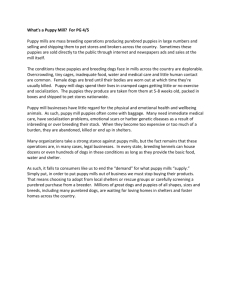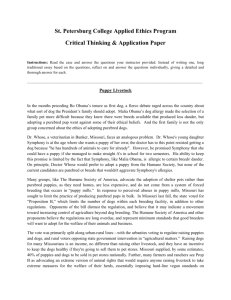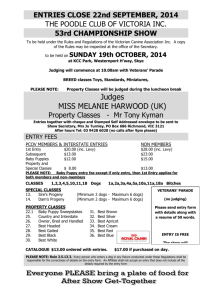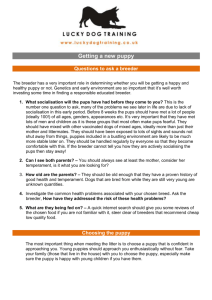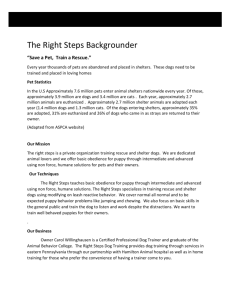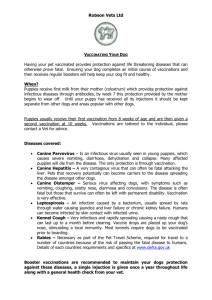Social Development - Laughing Dog CD
advertisement
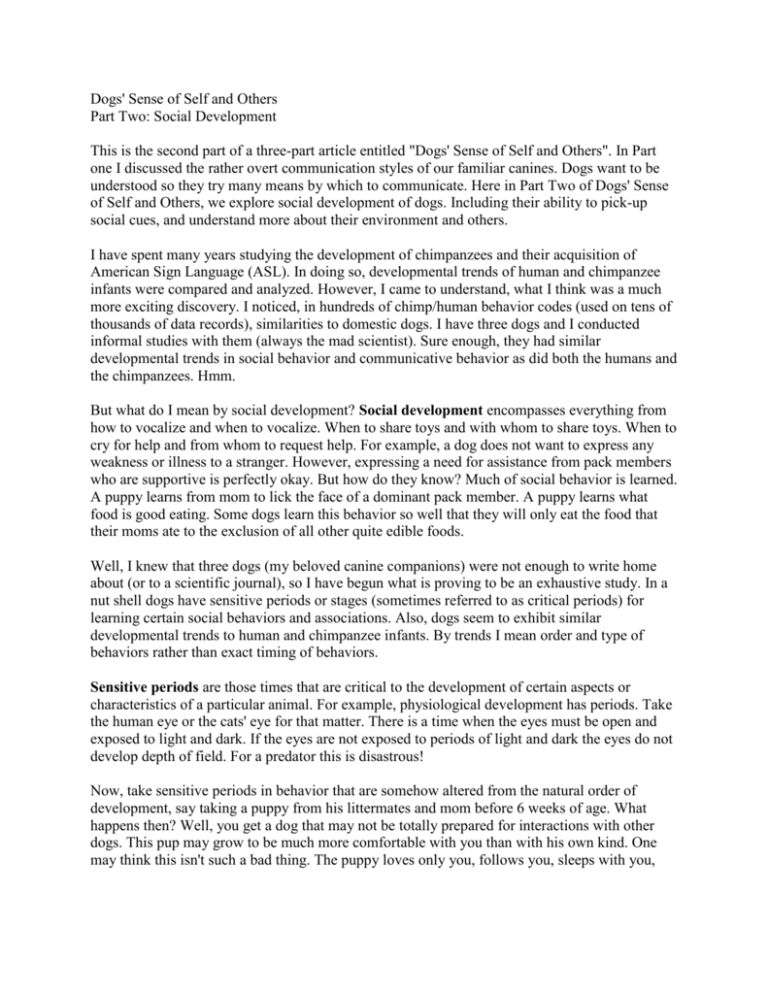
Dogs' Sense of Self and Others Part Two: Social Development This is the second part of a three-part article entitled "Dogs' Sense of Self and Others". In Part one I discussed the rather overt communication styles of our familiar canines. Dogs want to be understood so they try many means by which to communicate. Here in Part Two of Dogs' Sense of Self and Others, we explore social development of dogs. Including their ability to pick-up social cues, and understand more about their environment and others. I have spent many years studying the development of chimpanzees and their acquisition of American Sign Language (ASL). In doing so, developmental trends of human and chimpanzee infants were compared and analyzed. However, I came to understand, what I think was a much more exciting discovery. I noticed, in hundreds of chimp/human behavior codes (used on tens of thousands of data records), similarities to domestic dogs. I have three dogs and I conducted informal studies with them (always the mad scientist). Sure enough, they had similar developmental trends in social behavior and communicative behavior as did both the humans and the chimpanzees. Hmm. But what do I mean by social development? Social development encompasses everything from how to vocalize and when to vocalize. When to share toys and with whom to share toys. When to cry for help and from whom to request help. For example, a dog does not want to express any weakness or illness to a stranger. However, expressing a need for assistance from pack members who are supportive is perfectly okay. But how do they know? Much of social behavior is learned. A puppy learns from mom to lick the face of a dominant pack member. A puppy learns what food is good eating. Some dogs learn this behavior so well that they will only eat the food that their moms ate to the exclusion of all other quite edible foods. Well, I knew that three dogs (my beloved canine companions) were not enough to write home about (or to a scientific journal), so I have begun what is proving to be an exhaustive study. In a nut shell dogs have sensitive periods or stages (sometimes referred to as critical periods) for learning certain social behaviors and associations. Also, dogs seem to exhibit similar developmental trends to human and chimpanzee infants. By trends I mean order and type of behaviors rather than exact timing of behaviors. Sensitive periods are those times that are critical to the development of certain aspects or characteristics of a particular animal. For example, physiological development has periods. Take the human eye or the cats' eye for that matter. There is a time when the eyes must be open and exposed to light and dark. If the eyes are not exposed to periods of light and dark the eyes do not develop depth of field. For a predator this is disastrous! Now, take sensitive periods in behavior that are somehow altered from the natural order of development, say taking a puppy from his littermates and mom before 6 weeks of age. What happens then? Well, you get a dog that may not be totally prepared for interactions with other dogs. This pup may grow to be much more comfortable with you than with his own kind. One may think this isn't such a bad thing. The puppy loves only you, follows you, sleeps with you, Dogs’ Sense of Self and Others: Pt. 2 Social Development 2 cries when you leave, destroys the house in your absence, attacks other dogs that come to close to you… Now, take that same puppy that was taken from his littermates at a very early age (say 5 weeks) and now you have to go to work everyday. You come home and he is ready for a walk, but you are tired so you play with the dog at home, he has no opportunity to see the sights and hear the sounds of the neighborhood in which he will grow. Finally, summer comes and you have the time to take him out and about. You take your pup to the park, he encounters leaves rustling in the wind and he cowers between your legs. He sees a large park trash can and barks at it. He sees a kite flying high above and runs from you into the path of an oncoming car. Critical periods in behavior are just as important as critical periods for physical development. Literature on human and non-human social development indicates that the early experiences are important later in life. Veterinarians and behaviorists sometimes part company when it comes to the question of, "Should I take my puppy out and about before all his puppy shots are complete?" Behaviorists usually answer yes. With all the provisions of taking care that you introduce your puppy to "known vaccinated" puppy partners and "clean" locations. Veterinarians (until recently) usually answer no. The problem with the parting of ways by vets and behaviorists are the four natural stages or sensitive periods that pass while the puppy shots are being completed. Perhaps the veterinarians and the behaviorists should give the new pup owner all the information and let the human companion decide intelligently. The neonatal Period from birth to approximately 2 weeks: During this period puppies are sensitive to tactile stimuli and certain tastes (and possibly smells). Motor abilities are very limited. Neither the eyes nor the ear canals are open or functional. Regardless of this immature state neonatal puppies can learn simple associations. Short periods of daily handling can have marked long-term effects on behavioral development. These effects can include accelerated maturation of the nervous system, more rapid hair growth and weight gain, enhanced motor development and problem solving skills, and earlier eye opening. Pups handled during this period are found to be more confident, exploratory, and socially dominant. Transition Period from beginning of eye opening 13 (±3) to 18-20 days (ear canal opening): This is a period of rapid transition in which the patterns of behavior associated with neonatal existence disappear and are replaced by those more typical of later puppyhood and adult life. The whole transition period takes no more than one week. With the opening of the ear canal comes the first startle response to loud noises. Visual acuity and brain wave patterns increase. Puppies show an ability to crawl backwards, and begin to stand and walk. They start to urinate and defecate outside the nest. They can eliminate without their mother's stimulation. They show interest in solid food. Puppies begin to play-fight with one another, tail-wag, and growl. This is the same period at which young wolf pups would first emerge from the dark den. Socialization (and localization) Period from three weeks to twelve weeks (peak sensitivity 6-8 weeks): This period is the optimal time for socializing your puppy to new people, things, and locations. Puppies must be handled or socialized during this entire sensitive period. It seems that if puppies are introduced to socialization and then socializing stops, then the puppies can revert Dogs’ Sense of Self and Others: Pt. 2 Social Development 3 and become fearful again of humans and objects. Therefore it is not enough to introduce your happy go lucky puppy during this period to your uncle, and then expect that your uncle will be well received by your puppy 6 months later. During peak sensitivity (6-8 weeks) introduce your little guy to everything and everybody. Also this socialization peak is good time to introduce puppies to animals, such as cats, that you may want him to treat as one of his own kind. Keep up the good work for another month. But all your work is not over yet! Juvenile Period from 3 months to 8 months (for larger dogs longer & older): There is a second onset of heightened sensitivity to fear arousing stimuli around 4-6 months (this is also true in human children about 18 months). This is why being diligent is so important for your puppies social development. This is also the time when puppies suddenly "forget" everything ever taught them. Obedience commands such as COME seem like a foreign concept, when they want to do something else. Puppies may look at their human companions as if they have never heard the word before. Prenatal Period has been added to the list of sensitive periods, but that’s another article on breeding and bitch prenatal care. So how do sensitive periods relate to development of social behaviors like sharing? These sensitive periods and proper association built within these periods appear to be essential for the developmental patterns to emerge. For example, puppies first play rough as if the playmate does not feel pain. Early in the Socialization (and Localization) sensitivity period, the puppy is developing his/her sensory-motor skills. The intensity of bite is almost uncontrolled. However, the first time a puppy receives a hard bite, he yelps. Thus sending information to the biting offender. Also mom plays a part in teaching the puppy about biting. She will not tolerate being mauled while she is nursing. Puppies learn to moderate the level of play. This learned moderation is also true of chimps and children. Biting while rough and tumble play occurs is not moderated when children, chimps, and pups are very young. However, they exhibit moderation and bite less or with less pressure when they are socialized to do so. In all three populations sharing develops in stages. First taking without permission, then taking with permission, then offering an object to others without relinquishing the object, then offering and relinquishing the object. How many times did your puppy bring you a toy only to walk away with it after you started to reach for it? Puppies behave as if like a human child who wants to engage you, but does not want to relinquish the toy. However, later when nobody will play because the puppy or child will not share, the puppy or child learns that by sharing others will play and that he does not give up rights to play with the object again. Thus comes the final stage of sharing by offering and relinquishing the object. The relinquishing appears to be the most difficult concept for all three populations, human, chimp, and dogs. My final example is object permanence. All three populations develop object permanence in the same developmental order. First they see an object but cannot understand where it has gone Dogs’ Sense of Self and Others: Pt. 2 Social Development 4 when it is hidden, then they learn to understand that it is still there even though they cannot see it. This doesn't seem very difficult for me to understand that all dogs (and cats) seem to have object permanence, they are predators. It would be pretty silly if hunters could not understand that if a prey were running very fast in one direction and passes behind a boulder that it didn't actually disappear. Object permanence helps dogs know about their environment and others, and object permanence helps dogs understand the meaning of cues. Social cueing: The use of social cues to locate food, creatures, and other important "things" in and around the environment is a skill with obvious adaptive benefits. For example, an “informant” (say another dog) may look toward yet a third dog (or squirrel perhaps). This look with the eyes may be accompanied by both head and body orientation to the same location; and sometimes by other behaviors such as vocalizations or travel toward the target location. The ability of an observer, our dog, to exploit (or more gently said, "use") social cues of this type enables them to benefit from knowledge possessed only by another dog (or conspecific). So why are there humans who persist that dogs cannot understand cueing? Simple, dogs have never been tested— until recently. You and I know that our dogs understand our look to our shoes in the closet. Our dogs are watching our faces closely. It is almost scary when our dogs look at our faces then at our shoes and then the keys in our hand (and NO leash in hand). The look is all too familiar - WAIT HAVEN'T YOU FORGOTTEN SOMETHING? SOMEONE? What does any of this tell us about the dog's sense of self? This tells us that although they do not think as humans do (with visual imagery) perhaps they do understand basic concepts of social life, such as hurting others, sharing, and object permanence about their environment and others. As stated before, dogs have long been associated with humans. Recent DNA research suggests that the first round of domestication of dogs may have occurred as far back as 100,000 years ago. With this common history is it any wonder that dogs and humans can use social cueing as a way to understand one another? Is it any wonder that we have very similar patterns of development and a sense of self and others as our canine companions? Next time I will discuss canine companion research in part three of the Dog's Sense of Self and Others Series. Patricia is completing her Ph.D. in animal behavior and cognition. She has trained wild animals with the Zoological Society of San Diego. Her research interests are animal problem solving, learning, and communication. She lives in Spokane, WA with her husband Bob and their companion animals Trixie, Goodall, Foster (canines), Kimburu (feline), and Max & Pierre (avians). You can reach Patricia at PeTalk, (509) 456-8970 or trisha@petalk.org for private consultation on companion animal behavior and problems.


